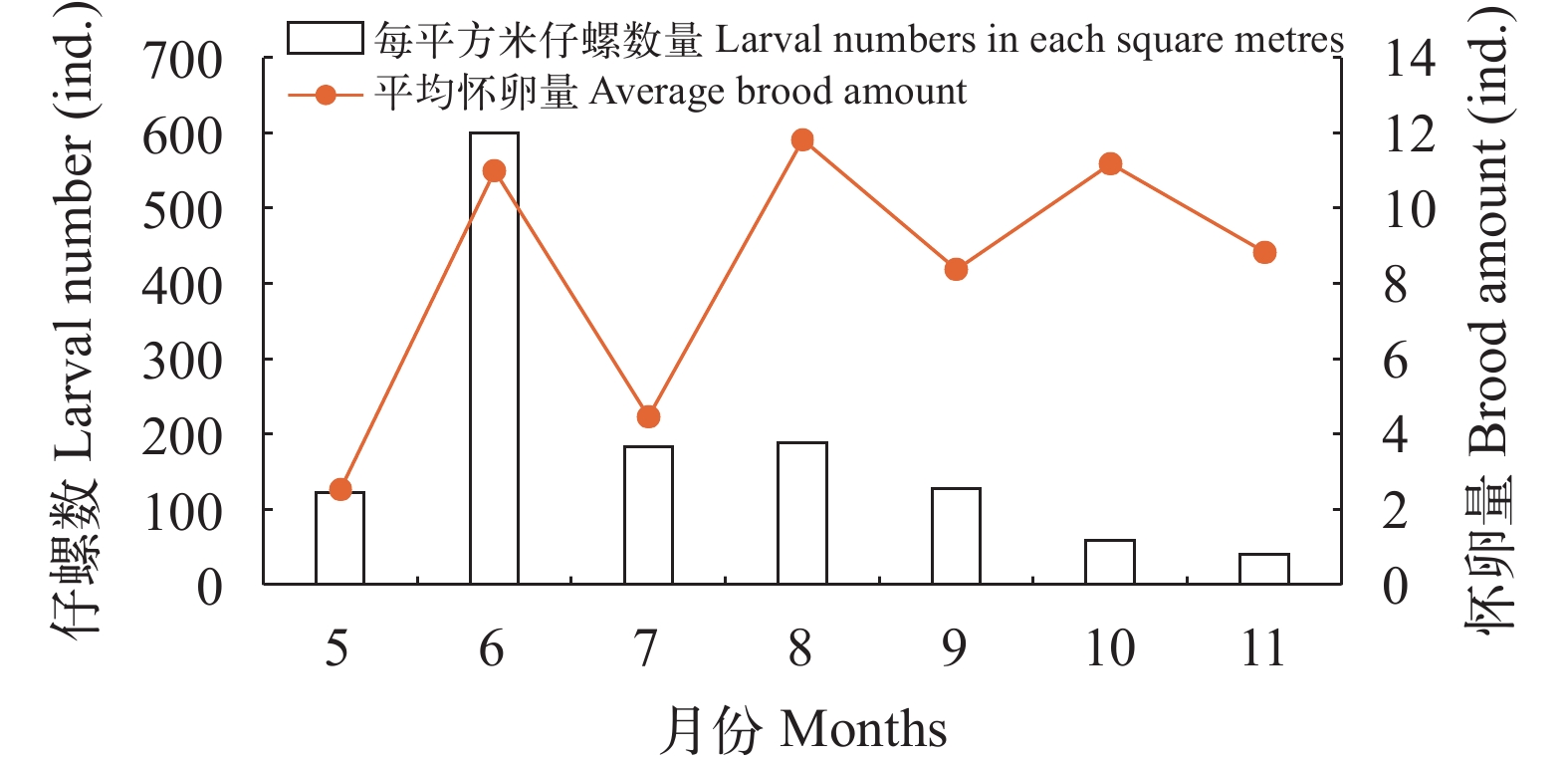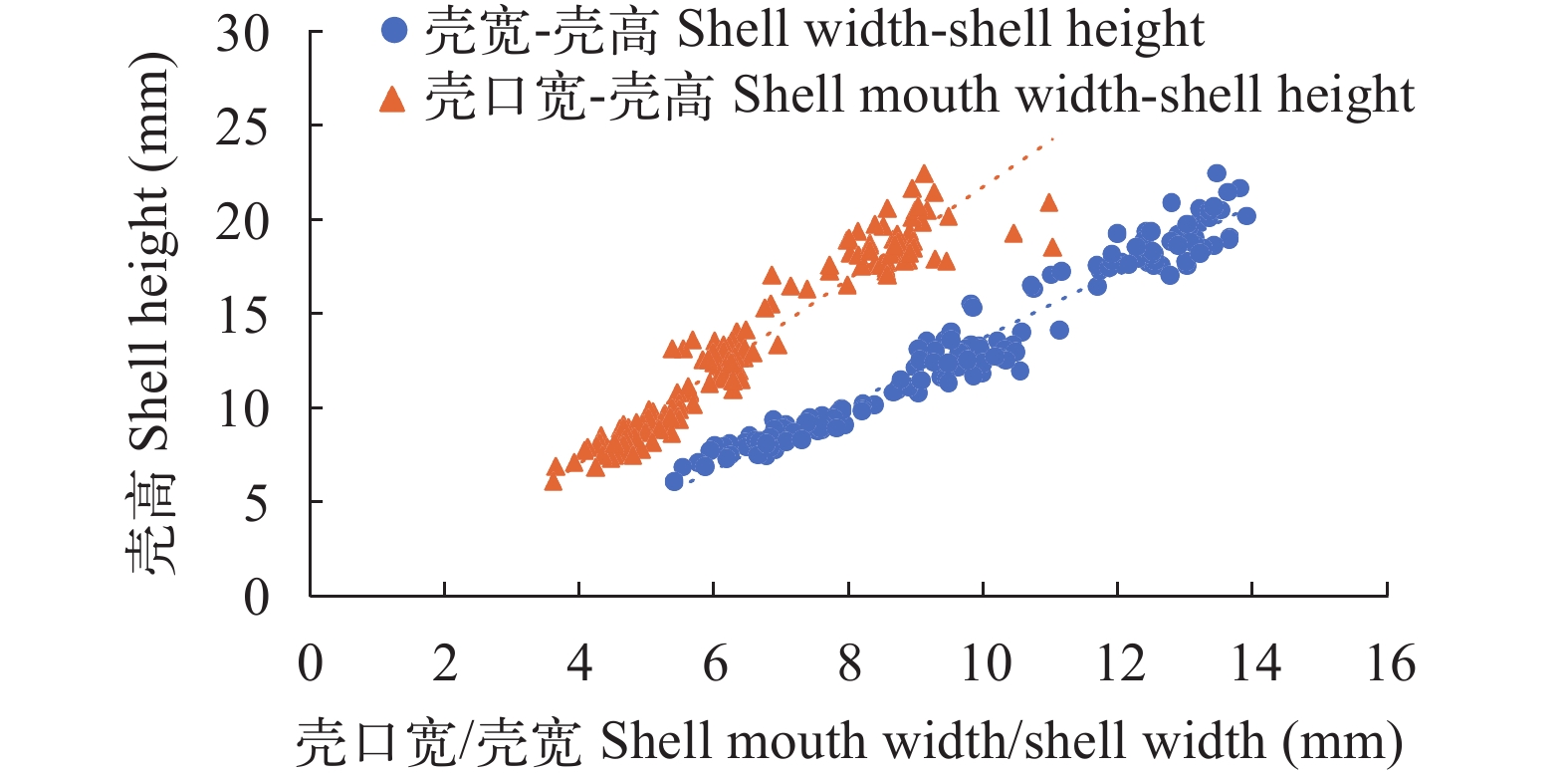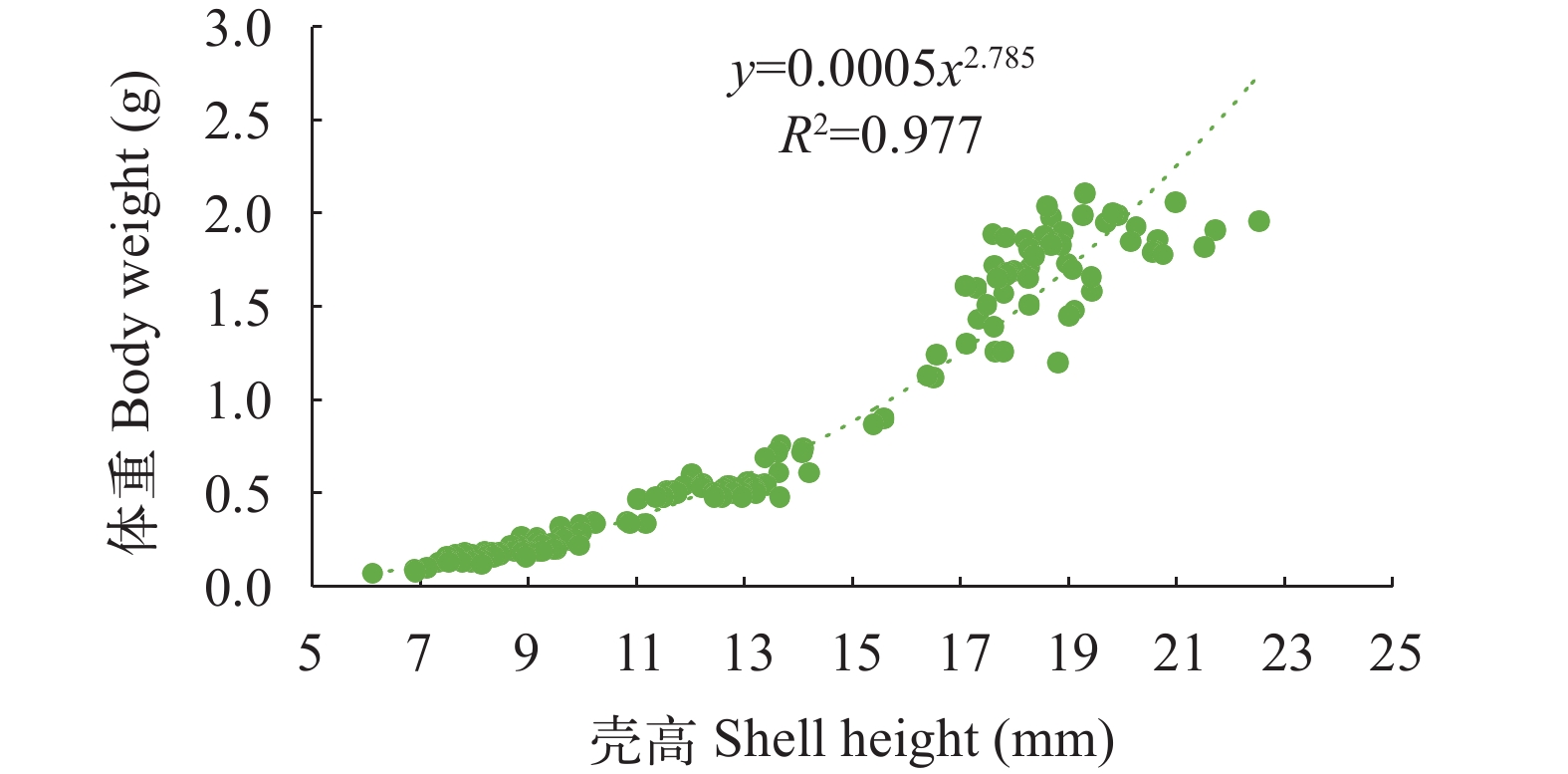THE REPRODUCTION AND GROWTH PATTERN OF LARVAE OF BELLAMYA AERUGINOSA CULTURED IN RICE FIELD
-
摘要: 为阐明稻田养殖模式下铜锈环棱螺的繁殖特点及仔螺的生长规律, 于2019年5—11月对稻田养殖的铜锈环棱螺进行逐月采样分析。研究结果表明, 稻田养殖铜锈环棱螺的产仔高峰期为6月, 仔螺的产出规律为2个月1个周期。最小繁殖体重为0.9 g, 最小繁殖月龄为2月龄。不同体重规格的性成熟雌螺, 其怀胚量与体重呈显著正相关, 随体重增加, 怀胚量呈显著增加的趋势。不同体重组间, 体重为1.00—3.99 g的铜锈环棱螺间的怀胚量没有显著差异, 而其他各体重组间均存在显著差异。仔螺生长特性, 6月和7月为铜锈环棱螺仔螺的快速生长期, 壳高相对增长率分别为47.95%和36.99%, 体重相对增长率分别为180.60%和128.43%。铜锈环棱螺仔螺壳宽、壳口宽与壳高呈正相关的线性关系, 壳高和体重呈正相关的幂函数关系, 壳高-体重拟合方程为W=0.0005H2.785, 壳高生长方程为Ht=19.368/(1+3.608e–1.056t), 拐点壳高为9.684 mm, 拐点月龄为1.215月, 最大月增高5.113 mm。体重生长方程为Wt =2.012e–5.051exp(–0.753t), 拐点体重为0.740 g, 拐点月龄为2.151月, 最大月增重0.557 g。综上, 稻田养殖铜锈环棱螺的产仔高峰期为6月, 2月龄达到性成熟, 6月和7月是仔螺的快速生长期。Abstract: Bellamya is an important freshwater snail, which widely distributes in different lakes. It has high nutritional value and is the main source of famous food, Liuzhou River snails rice noodle, and it had been mainly captured from the lake distributing in basin of the Yangtze River. With the implement of 10-year Fishing Ban on Yangtze River, the supply of wild Bellamya will be shut down. So, artificial culture become urgent and necessary. In order to supply Bellamya for Liuzhou River snails rice noodle, we carried out the experiment of reproduction and larval B. aeruginosa growth in rice field. The adult B. aeruginosa was captured from the lake in Hubei Province and transported to Liuzhou by truck in April, 2019. Then it was cultured in rice field with 667 m2 area in Liuzhuo, Guangxi Zhuang Autonomous Region. It was cultured 150 kg in each field. B. aeruginosa was fed with compound feed, and was sampled in 0.25 m2 area each month from May to November in 2019. The reproductive pattern and the brood amount were calculated. Meanwhile, the shell height, shell width, shell mouth width and body weight of larval B. aeruginosa were measured. The fitting equations and the growth equation were calculated. The main results were as follows: In rice field, the reproductive peak period of B. aeruginosa was in June. The reproductive cycle was 2 months during the reproductive period. The minimum body weight of reproductive individual was 0.9 g, and the minimum age of reproduction individual was 2 months. This result was similar to the results from the natural ecological group. The brood amount were significantly difference in different body weight groups, except in 1.00 g to 3.99 g groups, which were significantly related to body weight, and the heavier individual had the more brood mount. About the growth pattern, the rapid growth period of larval B. aeruginosa were June and July, then it is increased slowly from August. The relative growth rate of shell height were 47.95% and 36.99% in June and July, and the relative growth rate of body weight were 180.60% and 128.43% in June and July, respectively. This kind of growth pattern was similar to other aquatic organisms. In rice field, there were positive linear relationship between shell width/shell mouth width and shell height, and positive power regression between shell height and body weight. The fitting equations of the shell height and body weight of larval B. aeruginosa was W=0.0005 H2.785. Using three different growth equations, i.e. Bertallanffy, Logistic, and Gompertz, fit the growth model between shell height and the growth time, and body weight and the growth time. All three growth equations were fitting good. The expression of shell height growth equation of larval B. aeruginosa in rice field was Ht=19.368/(1+3.608e–1.056t). The height of inflection point was 9.684 mm, and the age of inflection point was 1.215 months. The maximum monthly increase was 5.113 mm. The expression of body weight growth equation was Wt=2.012e–5.051exp (–0.753t), and the inflection point weight was 0.740 g. The inflection point month age was 2.151 months, and the maximum monthly gain was 0.557 g. The growth of shell height and body weight showed allometric growth because the allometric growth factor b was 2.785 (b<3). According to our results, the reproductive peak period of B. aeruginosa was in June in rice field. The minimum age of reproduction individual was 2 months. The rapid growth period of larval B. aeruginosa was from June to July.
-
Keywords:
- Rice field culture /
- Reproduction /
- Larvae /
- Growth /
- Bellamya aeruginosa
-
环棱螺(Bellamya)是我国主要的淡水螺类之一, 广泛分布于湖泊水域[1]。近年来, 环棱螺凭借其螺肉的高营养价值[2]和良好的风味[3]等优点, 在水产品市场上占据的份额迅速提高, 成为餐桌上的佳品[4]。尤其是在全国推行的夜市经济和以柳州螺蛳粉产业为代表的加工产业, 极大地促进了市场对优质螺蛳原材料的需求。
环棱螺在自然条件下的生产力并不高。调查发现, 在大通湖[5]、武汉后湖[6]、武汉东湖[7]、郭郑湖、水果湖和扁担塘[8], 环棱螺的年生产力分别为684.11、33.13、91.56、286.74、604.99和15.77 g/(m2·a), 天然产量远远满足不了旺盛的市场需求。随着长江十年禁渔政策的正式实施, 湖北、湖南和江西等主产地对天然螺蛳资源的捕捞受到严格限制, 通过养殖来供应市场对环棱螺的需求必将成为主流, 发展环棱螺人工养殖势在必行。
目前环棱螺养殖模式主要有池塘主养和稻田养殖两种。稻田养殖相对于池塘主养在生态环境保护和利用土地资源上具有显著优势。关于环棱螺稻田养殖的相关研究, 目前未见报道。铜锈环棱螺(Bellamya aeruginosa)为我国的广布种, 个体较大, 环境适应能力强。因此, 本研究选取铜锈环棱螺作为养殖对象, 开展稻田养殖铜锈环棱螺繁殖与仔螺的生长特性研究, 旨在摸清该模式下铜锈环棱螺的繁殖特点及仔螺的生长规律, 为环棱螺的规模化人工养殖提供基础资料。
1. 材料与方法
1.1 稻田选用
试验稻田选在柳州市里高镇谷之韵螺蛳养殖试验基地, 基地水电、交通方便。选择15块面积各为 667 m2的稻田开展试验。试验稻田阳光充足, 水源充足, 水质良好, 无污染, 排灌方便。稻田养殖铜锈环棱螺时, 按照先投放种螺、后种植水稻的方式制定稻田养殖时间规划。试验稻田水稻为再生稻, 4月投放铜锈环棱螺种螺, 6月栽插水稻, 9月和11月收获稻谷两次, 次年4月收获铜锈环棱螺商品螺。
1.2 种螺放养
试验种螺来自湖北咸宁, 采用汽车运输的方式运送至柳州实验基地。种螺个体大、活力强, 均重为(3.12±1.23) g。2019年4月16日投放铜锈环棱螺种螺, 每塘各投放种螺150 kg。
1.3 养殖管理
试验稻田水位维持在15—30 cm, 种养期间没有晒田。定期灌注新水并定期检测水质, 保证试验稻田水质清新。种养期间稻田水质pH 7.0—8.5, 溶解氧大于5 mg/L, 水温15.0—33.2℃。2019年4—8月, 每天17:00投喂1次粉状料(主要营养成分: 蛋白质43%), 投喂率为1%。从8月20日开始, 投喂方式改为每两天投喂1次, 投喂饲料为粉状料和颗粒饲料(主要营养成分: 蛋白质32%)各占1/2。
1.4 数据采集
仔螺的采集 2019年5—11月, 随机选取3块稻田, 每月对铜锈环棱螺进行采样, 采样面积为0.25 m2。根据当月产出仔螺规格和第一螺层是否光滑有螺纹区分种螺与当月、当年新产出的仔螺。
繁殖参数采集 根据每月采集的样品中仔螺的数量变化规律来确定铜锈环棱螺的繁殖期。抽检不同规格的个体, 鉴别雌雄, 并统计雌螺怀胚个体百分比。将采集的螺按照体重0.00—0.99、1.00—1.99、2.00—2.99、3.00—3.99、4.00—4.99和5.00—5.99 g进行分组, 抽检各体重组的性成熟雌螺各30个, 统计怀胚量。
生长参数测定 抽检测量并记录铜锈环棱螺的壳高、壳宽、壳口宽、体重、大小螺数目等参数。长度精确到0.1 mm, 重量精确到0.1 g。
1.5 数据统计分析
用Excel软件处理基本生长数据, 以“平均值±标准差”(mean±SD)表示铜锈环棱螺仔螺生长参数。壳高H相对增长率(%)=(H2–H1)/H1×100; 体重W相对增长率(%)=(W2–W1)/W1×100。铜锈环棱螺的壳高与壳宽、壳口宽的关系用线性方程拟合; 体重和壳高的关系用W=aHb(其中W为体重, H为壳高, a和b为常数)模型进行拟合。利用SPSS20.0采用 Bertallanffy、Logistic和Gompertz 三种非线性生长模型(表 1)对铜锈环棱螺仔螺壳高和体重进行生长模型构建[9]。
表 1 三种常用动物生长曲线模型Table 1. Three common growth curve model in animals名称
Name模型
Model拐点体重W
Inflection
point weight拐点月龄At
Inflection
point months age最大月增重Mg
Maximum
monthly gainBertallanffy Wt=A
(1–Be–kt)38A/27 (ln3B)/k 3kW/2 Logistic LWt=A/
(1+Be–kt)A/2 (lnB)/k kW/2 Gompertz Wt=Ae–Bexp(–kt) A/e (lnB)/k kW 注: k为瞬时相对生长率; W为拐点体重, A为极限生长量; B为调节参数; Wt为t时的体重估计值Note: k is the instantaneous relative growth rate; W is the weight at inflection point, A is the limit growth; B is the adjustment parameter; Wt is the estimated weight at t 2. 结果
2.1 稻田养殖铜锈环棱螺的繁殖特点
仔螺数量和雌螺怀胚量逐月变化特点 图 1所示, 仔螺数量以6月最高, 显著高于其他月份, 是全年仔螺出生的最高峰; 其他月份呈波动性、且逐渐降低的趋势。怀胚量呈周期性波动的变化, 每两个月有1个峰值, 说明铜锈环棱螺的怀胚量具有每两个月为1个周期的变化特点。
性腺发育特征 如表 2所示, 体重0.3—0.5 g, 仅6.7%的螺有未发育成熟的雄性性腺, 其他个体均为性腺未发育、无法区分雌雄。体重0.5—0.7 g, 43.3%的螺已能观察到性腺发育, 且有6.7%的雌螺已怀有胚胎。0.7—0.9 g, 怀胚的雌螺占比23.3%, 且部分雌螺卵巢中已经出现了成形的仔螺。雌螺的体重超过0.7 g时, 有近50%的个体怀有胚胎。0.9 g以上的螺性腺发育基本完成, 可以观察到成形的性腺, 此规格的螺对应的月龄约为2月龄。在能够区分雌雄的个体中, 除了低体重组外, 雌雄比例均接近1﹕1。
表 2 铜锈环棱螺性腺发育情况Table 2. The gonad development of B. aeruginosa体重规格
Body weight size (g)样本量
Sample number性腺发育个体百分比
Percent of gonadal
developmental individuality (%)雄性个体百分比
Percent of male (%)雌性个体百分比
Percent of female (%)怀胚个体百分比
Percent of pregnant
individual (%)0.30—0.49 30 6.7 6.7 0.0 0.0 0.50—0.69 30 43.3 26.7 16.6 6.7 0.70—0.89 30 86.7 40.0 46.7 23.3 0.90—1.09 30 93.3 50.0 43.3 23.3 1.10—1.29 30 100.0 46.7 53.3 30.0 对不同规格的个体进行解剖, 分不同规格统计怀胚个体的怀胚量。由表 3可知, 不同体重的铜锈环棱螺平均怀胚量之间存在差异, 1.00—1.99 、2.00—2.99和3.00—3.99 g等3 个体重组间的铜锈环棱螺怀胚量差异不显著, 而0.00—0.99 g组与1.00—1.99 g组间、3.00—3.99 g与4.00—4.99 g组间、4.00—4.99 g与5.00—5.99 g组间存在显著差异。另外, 体重越大的个体, 其平均怀胚量越多。
表 3 不同体重的铜锈环棱螺怀胚量Table 3. The brood amount of different body weight of B. aeruginosa体重规格
Body weight size (g)样本量
Sample number平均怀胚量
Average brood amount0.00—0.99 15 1.40a 1.00—1.99 50 7.04b 2.00—2.99 74 7.92b 3.00—3.99 31 8.55b 4.00—4.99 16 17.06c 5.00—5.99 5 26.60d 注: 不同小写字母表示差异显著(P<0.05)Note: Different lowercase letters mean significant differences (P<0.05) 2.2 铜锈环棱螺的生长
铜锈环棱螺壳高体重生长规律 由表 4可知, 铜锈环棱螺仔螺壳高、体重的快速增长期为6月和7月, 壳高相对增长率分别为47.95%和36.99%, 体重相对增长率分别为180.60%和128.43%, 表明铜锈环棱螺出生后的前3个月是其快速生长发育期。
表 4 铜锈环棱螺仔螺壳高、体重及相对增长率Table 4. The shell height, body weight and relative growth rate of larval B. aeruginosa月份
Month壳高
Shell
height (mm)壳高相对
增长率
Relative growth
rate of shell
height (%)体重
Body
weight (g)体重相对
增长率
Relative growth
rate of body
weight (%)5 8.75±1.06 0.21±0.08 6 12.94±1.08 47.95 0.58±0.13 180.60 7 17.73±0.92 36.99 1.31±0.11 128.43 8 18.05±0.77 1.81 1.55±0.04 18.26 9 18.18±0.67 0.76 1.68±0.03 8.05 10 19.57±1.3 7.60 1.87±0.07 11.58 11 19.67±0.87 0.54 2.05±0.04 9.56 注: 5月为新生铜锈环棱螺出生后第1个月, 故不计算相对增长率Note: May is the first month after larval B. aeruginosa birth, so the relative growth rate is not calculated 8—11月, 铜锈环棱螺仔螺壳高增长几乎停滞, 仅在10月有小幅度提高; 体重则表现为增长率保持在较低水平的持续增长, 增长接近匀速。壳高发育的停滞和体重的不间断发育, 表明在铜锈环棱螺快速增长期过后, 体重增长的主要推动力不再来源于壳高发育, 而是转向壳宽、壳口宽增长所带来的提升; 铜锈环棱螺的主要繁殖期也在此时间段内。8月以后, 仔螺的增速逐渐平缓减慢。
生长方程 由图 2和图 3可知, 稻田养殖铜锈环棱螺仔螺壳宽D、壳口宽E与壳高H呈正相关的线性关系, 回归方程分别为H=1.7603D–3.8293(R2=0.9571)、H=2.4583E–2.7566(R2=0.9266)。壳高H和体重W呈正相关的幂函数关系, 拟合方程为W=0.0005H2.785(R2=0.9770)。3个回归方程的回归系数平方值均高于0.9, 说明方程的可信度较高。
壳高体重拟合方程的系数和指数分别被称为条件因子a和异速增长因子b, 分别与铜锈环棱螺的肥满度和两指标的增长差异程度有关。当b=3时, 水产动物按理想模型壳高体重等速增长[10]。铜锈环棱螺壳高体重关系方程的异速增长因子为2.785, 与3有差异, 表明稻田养殖铜锈环棱螺仔螺的壳高体重增长并不同步, 为异速增长。
生长模型构建 应用三种生长方程Bertallanffy、Logistic、Gompertz拟合铜锈环棱螺仔螺的体重、壳高和生长时间之间的生长模型, 得到各生长方程的相关参数、拐点月龄、拐点壳高/体重及最大月增长量(表 5)。三种生长方程对铜锈环棱螺仔螺壳高体重与时间的生长模型拟合精度均很高; 体重或壳高在运用不同的生长方程拟合后, 得到的生长方程的拟合度之间数值差异不大。
表 5 三种生长方程对铜锈环棱螺仔螺壳高体重生长模型拟合参数Table 5. Fitting parameters of three growth equations for height/weight growth model of larval B. aeruginosa指标
Index生长方程
Growth equation参数Parameter 拐点壳高H/体重W
Inflection point shell
height/body weight拐点月龄
Inflection point
months age最大月增加量Hmm/Mg
Maximum monthly
gainA B K R2 壳高
Shell heightBertallanffy 19.861 1.056 0.619 0.973 5.885 1.863 5.464 Logistic 19.368 3.608 1.056 0.978 9.684 1.215 5.113 Gompertz 19.569 1.881 0.824 0.976 7.199 0.767 5.932 体重
Body weightBertallanffy 2.376 1.278 0.311 0.98 0.704 4.321 0.328 Logistic 1.921 22.65 1.198 0.977 0.961 2.604 0.575 Gompertz 2.012 5.051 0.753 0.984 0.740 2.151 0.557 三种生长方程对铜锈环棱螺仔螺壳高拟合度按大小排序为logistic生长方程>Gompertz生长方程>Bertallanffy生长方程; 体重拟合度按大小排序为Gompertz生长方程>Bertallanffy>logistic生长方程。
依据拟合精度大小排列顺序, 可得铜锈环棱螺仔螺壳高体重理论生长方程、拐点壳高、拐点体重、拐点月龄以及最大月增长量。仔螺壳高生长方程为Ht=19.368/(1+3.608e–1.056 t), 拐点壳高为9.684 mm, 拐点月龄为1.215月, 最大月增高5.113 mm。仔螺体重生长方程为Wt=2.012e–5.051exp(-0.753 t), 拐点体重为0.740 g, 拐点月龄为2.151月, 最大月增重0.557 g。
3. 讨论
3.1 铜锈环棱螺仔螺出生的逐月变化规律
在铜锈环棱螺养殖周期内, 6月所产仔螺的数量显著高于其他月份, 说明稻田养殖铜锈环棱螺的产仔高峰期为6月, 这与陈其羽和宋贵保[11]所报道的自然生态条件下铜锈环棱螺的产卵高峰期为6月的结果一致。说明养殖条件下铜锈环棱螺的产仔繁殖规律与自然生态条件下具有一致性。
根据本文的结果, 铜锈环棱螺的怀胚量呈现有规律的每两个月有1次高峰的变化特点。此结果与铜锈环棱螺的性腺成熟月龄(拐点月龄为2.151月龄)相吻合。另外, 0.9 g以上的环棱螺性腺发育基本完成, 可以观察到成形的性腺, 此规格的螺对应的月龄约为2月龄, 此结果也与自然生态条件下的结果一致[11]。由此说明, 稻田养殖铜锈环棱螺可以自然繁殖和生长, 维持与自然生长状态一致的种群自然繁衍规律。
3.2 稻田养殖铜锈环棱螺仔螺的生长规律
稻田养殖铜锈环棱螺仔螺的壳高和体重快速增长期在6月和7月, 两月间, 壳高相对增长率为47.95%, 体重相对增长率为180.60%。在8月之后, 仔螺的壳高和体重增速逐渐减慢变缓。铜锈环棱螺的这种生长特点, 与其他水生变温动物的生长规律一致[12]。部分淡水螺仔螺的生长呈现早期生长速度快, 后期生长速度放缓的现象, 如在实验室水泥池养殖条件下, 60日龄时梨形环棱螺体重为(0.471±0.220) g[13]。福寿螺(Pomacea canaliculata)在个体较小时生长速度快, 个体较大时生长速度慢, 出生后30—60 d时生长速度最快[14]。这种生长规律受其他外部条件(如饲料和水温)的影响。在养殖期间, 5—7月主要投喂粉状饲料, 仔螺的摄食率和摄食量相对较高, 加上温度的影响, 加快了仔螺的生长。在8月之后, 主要投喂饲料变为颗粒饲料, 由于环棱螺本身的摄食方式为刮食, 一批仔螺无法及时地对大颗粒饲料取食, 摄食量减少加之生长规律的影响, 因此生长速度受到影响, 表现出生长逐渐变缓。
水生经济动物的体长-体重关系被广泛地应用于对水产经济动物的研究中[15, 16]。本研究对铜锈环棱螺仔螺的生长指标分析后发现, 稻田养殖条件下铜锈环棱螺仔螺的壳宽与壳高、壳口宽与壳高呈线性关系; 壳高体重之间呈幂函数关系。铜锈环棱螺仔螺壳高体重关系方程异速增长因子为2.785, 说明稻田养殖条件下铜锈环棱螺仔螺壳高、体重生长并不同步, 为异速增长。福寿螺[17]和耳河螺(Rivularia auriculata)[18]壳高和体重之间的关系也符合异速生长方程。生长模型是用于研究生物个体生长发育模式的常用工具。本研究用3种非线性生长模型Bertalanffy、Gompertz和Logistic研究铜锈环棱螺仔螺的体质量性状的生长发育规律, 比较不同生长方程的拟合度数值, 确定最佳的新生环棱螺理论生长模型。比较的结果, 铜锈环棱螺仔螺的壳高和体重生长分别以logistic生长方程和Gompertz生长方程拟合。
4. 结论
稻田养殖铜锈环棱螺的产仔高峰期为6月, 每2个月为1个产仔周期, 最小繁殖月龄为2月龄。不同体重组间的怀胚量, 除体重为1.00—3.99 g各组间无差异外, 其他各体重组间均存在显著差异。仔螺生长特性, 6月和7月为铜锈环棱螺仔螺的快速生长期。铜锈环棱螺仔螺壳高–体重拟合方程为W=0.0005H2.785, 壳高的生长方程为Ht=19.368/(1+3.608e–1.056t), 体重生长方程为Wt=2.012e–5.051exp(–0.753t), 拐点月龄为2.151月, 最大月增重0.557 g。
-
表 1 三种常用动物生长曲线模型
Table 1 Three common growth curve model in animals
名称
Name模型
Model拐点体重W
Inflection
point weight拐点月龄At
Inflection
point months age最大月增重Mg
Maximum
monthly gainBertallanffy Wt=A
(1–Be–kt)38A/27 (ln3B)/k 3kW/2 Logistic LWt=A/
(1+Be–kt)A/2 (lnB)/k kW/2 Gompertz Wt=Ae–Bexp(–kt) A/e (lnB)/k kW 注: k为瞬时相对生长率; W为拐点体重, A为极限生长量; B为调节参数; Wt为t时的体重估计值Note: k is the instantaneous relative growth rate; W is the weight at inflection point, A is the limit growth; B is the adjustment parameter; Wt is the estimated weight at t 表 2 铜锈环棱螺性腺发育情况
Table 2 The gonad development of B. aeruginosa
体重规格
Body weight size (g)样本量
Sample number性腺发育个体百分比
Percent of gonadal
developmental individuality (%)雄性个体百分比
Percent of male (%)雌性个体百分比
Percent of female (%)怀胚个体百分比
Percent of pregnant
individual (%)0.30—0.49 30 6.7 6.7 0.0 0.0 0.50—0.69 30 43.3 26.7 16.6 6.7 0.70—0.89 30 86.7 40.0 46.7 23.3 0.90—1.09 30 93.3 50.0 43.3 23.3 1.10—1.29 30 100.0 46.7 53.3 30.0 表 3 不同体重的铜锈环棱螺怀胚量
Table 3 The brood amount of different body weight of B. aeruginosa
体重规格
Body weight size (g)样本量
Sample number平均怀胚量
Average brood amount0.00—0.99 15 1.40a 1.00—1.99 50 7.04b 2.00—2.99 74 7.92b 3.00—3.99 31 8.55b 4.00—4.99 16 17.06c 5.00—5.99 5 26.60d 注: 不同小写字母表示差异显著(P<0.05)Note: Different lowercase letters mean significant differences (P<0.05) 表 4 铜锈环棱螺仔螺壳高、体重及相对增长率
Table 4 The shell height, body weight and relative growth rate of larval B. aeruginosa
月份
Month壳高
Shell
height (mm)壳高相对
增长率
Relative growth
rate of shell
height (%)体重
Body
weight (g)体重相对
增长率
Relative growth
rate of body
weight (%)5 8.75±1.06 0.21±0.08 6 12.94±1.08 47.95 0.58±0.13 180.60 7 17.73±0.92 36.99 1.31±0.11 128.43 8 18.05±0.77 1.81 1.55±0.04 18.26 9 18.18±0.67 0.76 1.68±0.03 8.05 10 19.57±1.3 7.60 1.87±0.07 11.58 11 19.67±0.87 0.54 2.05±0.04 9.56 注: 5月为新生铜锈环棱螺出生后第1个月, 故不计算相对增长率Note: May is the first month after larval B. aeruginosa birth, so the relative growth rate is not calculated 表 5 三种生长方程对铜锈环棱螺仔螺壳高体重生长模型拟合参数
Table 5 Fitting parameters of three growth equations for height/weight growth model of larval B. aeruginosa
指标
Index生长方程
Growth equation参数Parameter 拐点壳高H/体重W
Inflection point shell
height/body weight拐点月龄
Inflection point
months age最大月增加量Hmm/Mg
Maximum monthly
gainA B K R2 壳高
Shell heightBertallanffy 19.861 1.056 0.619 0.973 5.885 1.863 5.464 Logistic 19.368 3.608 1.056 0.978 9.684 1.215 5.113 Gompertz 19.569 1.881 0.824 0.976 7.199 0.767 5.932 体重
Body weightBertallanffy 2.376 1.278 0.311 0.98 0.704 4.321 0.328 Logistic 1.921 22.65 1.198 0.977 0.961 2.604 0.575 Gompertz 2.012 5.051 0.753 0.984 0.740 2.151 0.557 -
[1] 顾钱洪. 中国不同地理种群环棱螺遗传多样性和分类阶元的研究 [D]. 武汉: 华中农业大学, 2013: 13. Gu Q H. Genetic diversity and taxonomy of Bellamya populations from different geographic regions in China [D]. Wuhan: Huazhong Agricultural University, 2013: 13.
[2] 陈李婷, 杜雪松, 文衍红, 等. 广西地区3种螺的含肉率及营养成分分析 [J]. 肉类工业, 2019(10): 20-22. doi: 10.3969/j.issn.1008-5467.2019.10.007 Chen L T, Du X S, Wen Y H, et al. Analysis of meat content and nutrient composition of three kinds of snails in Guangxi area [J]. Meat Industry, 2019(10): 20-22. doi: 10.3969/j.issn.1008-5467.2019.10.007
[3] 孟凡国, 史红专, 王嘉, 等. 蚂蟥与梨形环棱螺营养成分的相关性研究 [J]. 中国中药杂志, 2013, 38(12): 1915-1918. Meng F G, Shi H Z, Wang J, et al. Correlation analysis between nutritive components of Whitmania pigra and Bellamya purificata [J]. China Journal of Chinese Materia Medica, 2013, 38(12): 1915-1918.
[4] 文衍红, 覃惠明, 黄杰, 等. 环棱螺相关产品加工业餐饮业市场现状及前景展望 [J]. 中国水产, 2018(10): 42-45. Wen Y H, Qin H M, Huang J, et al. Current situation and prospect of food and beverage market in processing industry of Bellamya related products [J]. China Fisheries, 2018(10): 42-45.
[5] 王桂苹, 李雪林, 皮杰, 等. 大通湖环棱螺的次级生产力 [J]. 水生生物学报, 2014, 38(5): 987-992. doi: 10.7541/2014.146 Wang G P, Li X L, Pi J, et al. Secondary production of Bellamya in Lake Datong [J]. Acta Hydrobiologica Sinica, 2014, 38(5): 987-992. doi: 10.7541/2014.146
[6] 阎云君, 梁彦龄, 王洪铸. 武汉后湖铜锈环棱螺的周年生产量 [J]. 湖泊科学, 2000, 12(1): 68-72. doi: 10.3321/j.issn:1003-5427.2000.01.011 Yan Y J, Liang Y L, Wang H Z. Annual production of Bellamya aeruginosa in Houhu Lake, Wuhan [J]. Journal of Lake Sciences, 2000, 12(1): 68-72. doi: 10.3321/j.issn:1003-5427.2000.01.011
[7] 陈其羽. 武汉东湖铜锈环棱螺种群变动和生产量的初步观察 [J]. 水生生物学报, 1987, 11(2): 117-130. Chen Q Y. A preliminary study on the population dynamics and annual production of Bellamya aeruginosa (Reeve) in Lake Dong Hu, Wuhan [J]. Acta Hydrobiologica Sinica, 1987, 11(2): 117-130.
[8] 阎云君, 梁彦龄, 王洪铸. 扁担塘螺类生产力的研究Ⅰ. 铜锈环棱螺的周年生产量 [J]. 水生生物学报, 1999, 23(4): 346-351. doi: 10.3321/j.issn:1000-3207.1999.04.008 Yan Y J, Liang Y L, Wang H Z. production of gastropods in lake Biandantang Ⅰ. Annual production of Bellamya aeruginosa [J]. Acta Hydrobiologica Sinica, 1999, 23(4): 346-351. doi: 10.3321/j.issn:1000-3207.1999.04.008
[9] Preacher K J, Hayes A F. SPSS and SAS procedures for estimating indirect effects in simple mediation models [J]. Behavior Research Methods Instruments & Computers, 2004, 36(4): 717-731.
[10] Martínez-Montaño E, González-Álvarez K, Lazo J P, et al. Morphological development and allometric growth of yellowtail kingfish Seriola lalandi. V. larvae under culture conditions [J]. Aquaculture Research, 2016, 47(4): 1277-1287. doi: 10.1111/are.12587
[11] 陈其羽, 宋贵保. 铜锈环棱螺繁殖和生长的初步研究 [J]. 水生生物学集刊, 1975, 5(4): 519-534. Chen C Y, Song K P. A preliminary study on reproduction and growth of the snail, Bellamya aeruginosa (Reeve) [J]. Acta Hydrobiologica Sinica, 1975, 5(4): 519-534.
[12] 徐大凤, 刘永胜, 常青, 等. 真蛸早期发育形态特征及生长规律研究 [J]. 渔业科学进展, 2019, 40(5): 145-154. doi: 10.19663/j.issn2095-9869.20180726001 Xu D F, Liu Y S, Chang Q, et al. Morphology, growth and development in the early life of Octopus vulgaris [J]. Progress in Fishery Sciences, 2019, 40(5): 145-154. doi: 10.19663/j.issn2095-9869.20180726001
[13] 颜元杰, 金武, 闻海波, 等. 梨形环棱螺60日龄6个生长性状遗传参数估计 [J]. 淡水渔业, 2018, 48(6): 108-111. doi: 10.3969/j.issn.1000-6907.2018.06.017 Yan Y J, Jin W, Wen H B, et al. Estimation of genetic parameters for growth traits of Bellamya purificata in 60 days [J]. Freshwater Fisheries, 2018, 48(6): 108-111. doi: 10.3969/j.issn.1000-6907.2018.06.017
[14] 朱丽霞, 黄瑶瑶, 张泽宏, 等. pH、食物和光周期对福寿螺生长发育和繁殖的影响 [J]. 生态学报, 2015, 35(8): 2643-2651. Zhu L X, Huang Y Y, Zhang Z H, et al. Effects of pH, food and photoperiod on the growth, development and reproduction of Pomacea canaliculata [J]. Acta Ecologica Sinica, 2015, 35(8): 2643-2651.
[15] Gaygusuz Ö, Aydın H, Emiroğlu Ö, et al. Length-weight relationships of freshwater fishes from the western part of Anatolia, Turkey [J]. Journal of Applied Ichthyology, 2013, 29(1): 285-287. doi: 10.1111/jai.12015
[16] Vicentin W, dos S Costa F E, Súarez Y R. Length-weight relationships and length at first maturity for fish species in the upper Miranda River, southern Pantanal wetland, Brazil [J]. Journal of Applied Ichthyology, 2012, 28(1): 143-145. doi: 10.1111/j.1439-0426.2011.01890.x
[17] 房苗, 徐猛, 罗渡, 等. 入侵种福寿螺的养殖液对水环境及本地种铜锈环棱螺的影响 [J]. 生态学杂志, 2016, 35(7): 1879-1888. Fang M, Xu M, Luo D, et al. Impact of aquaculture liquid from invasive species apple snails (Pomacea canaliculata) on water quality and indigenous species Bellamya aeruginosa [J]. Chinese Journal of Ecology, 2016, 35(7): 1879-1888.
[18] 邹丽珍, 崔利峰, 蒋奕雄, 等. 建瓯耳河螺种群动态研究 [J]. 水产学杂志, 2021, 34(1): 54-59. doi: 10.3969/j.issn.1005-3832.2021.01.010 Zou L Z, Cui L F, Jiang Y X, et al. Population dynamics of river snail Rivularia auriculata in Jianou, Fujian Province [J]. Chinese Journal of Fisheries, 2021, 34(1): 54-59. doi: 10.3969/j.issn.1005-3832.2021.01.010
-
期刊类型引用(1)
1. 王帅兵,熊良伟,曹又文,宋扬,王海华,刘波. 折叠萝卜螺卵粒孵化时间及不同饵料对仔螺生长的影响. 上海海洋大学学报. 2024(03): 615-622 .  百度学术
百度学术
其他类型引用(0)



 下载:
下载:


